
Connected Smart Kitchen
Find and compare Connected Wifi Kitchen Gadgets. Remotely monitor and control cooking devices and appliances from your iphone or Android smartphone app.
The kitchen has often been called “the heart of the home”—but why can’t it be the brains, too? The Internet of Things is making possible a new wave of smart kitchen gadgets, from sensors that know when the stove has been left on to forks that remind us to slow down and savor each bite. Here’s a roundup of IoT products that are changing the way we order, store, cook and consume food in our homes. The following Channel Guide will help you:
- Sort and compare devices based on function, app scores and pricing.
- Determine if the gadget is compatible with your Android or iOS device and existing smart home hub system.
- Point you to more resources on tutorials, instruction manuals and how to get the best results from your newly connected kitchen.
12/19/2019
Featured
A spotlight on a smart kitchen product that lives up to its hype of making better food for your family.
AeroGarden Harvest Elite WiFi
Highlights
- Grow up to 6 plants in soil less pods
- Most plants germinate within 7-14 days, are ready for harvesting in 4-6 weeks
- Non-GMO Seeds
Grocery Ordering
Barcodes aren’t just for cashiers anymore. The following devices let consumers use them in the home as a quick way to manage shared grocery lists. In addition to scanning barcodes, these gadgets can also accept voice commands and even place grocery delivery orders to save you a trip to the store.

Amazon Dash
Description:
The Dash wand collects items for your list and orders them through Amazon Fresh, a local delivery service which also includes hundreds of thousands of non-grocery Amazon items. Fresh is still being rolled out to select cities, so Dash isn’t yet widely available.
Price: $Unknown; beta by invitation only
Connectivity: WiFi
Additional: Postscapes Coverage

Hiku
Description:
Hiku is much more than a chunky fridge magnet. As you scan or tell it which groceries you need, it can integrate with a number of third-party shopping lists. Planned updates will add online price comparisons and online ordering, though specific grocery delivery partners haven’t been announced yet.
Price: $79
Connectivity: WiFi
Additional: Postscapes Coverage
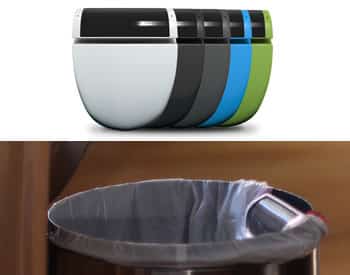
GeniCan
Description:
GeniCan may be the only commercial IoT device that’s actually meant to be unboxed and put straight in the trash. Perching on the lid of a waste bin, it scans or takes voice recordings to track items as you throw them away, so you’re always ready to restock the pantry. Online ordering is planned, but no word yet on who the delivery partners will be.
Price: $149
Connectivity: WiFi
Additional: Postscapes Coverage
Monitors & Alarms
Even for the best home chefs, things sometimes go wrong. Here are a few devices that help keep an eye on things and can pass alerts about a problem at home to users anywhere in the networked world.
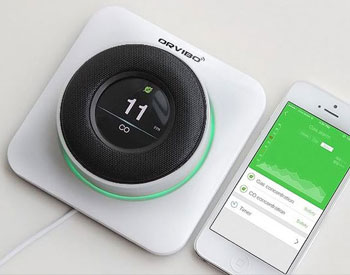
Kepler
Description:
Kepler, a natural gas and carbon monoxide monitor, could just as easily live in any room of the house, or even in the basement near a gas-fired boiler. But it’s especially useful in the kitchen, where it can check for gas buildup from a leaky or forgotten stove. It also doubles as a handy kitchen timer—twist the dial to set a countdown, and wave your hand to silence alarms.
Price: Unknown
Connectvity: Wifi
Additional: Postscapes Coverage

Birdi
Description:
Smoke is just one of the many air quality indicators Birdi monitors. Others include carbon monoxide, pollen, particulates, temperature and humidity. If any of these rise to worrisome levels, Birdi will alert you and anyone else you authorize -- family, friends, neighbors -- with a text message, or an automated call to a landline. That way you’ll know something’s wrong even when you’re not at home to hear the alarm. Multiple Birdi devices can also repeat alarms from other rooms or even other houses if your neighbors connect their Birdi to yours.
Price: $119
Connectvity: Wifi
Additional: Postscapes Coverage
Flatware & Utensils
Parents may impose a “no screens” rule at the dinner table, but that doesn’t mean your meal can’t involve some smart technology. Here a few devices that use data and immediate feedback to help us be more mindful of what we’re eating and drinking.

Vessyl
Description:
Beverage calories are some of the hardest to eliminate, especially when we’ve become dependent on caffeine and sugar boosts to get us through the day. Vessyl does the thinking for you, with internal sensors that analyze the ingredients to determine what, how much and how often you’re drinking—as well as tracking nutritional metrics like caffeine intake, calories consumed, and hydration.
Price: $199 expected retail
Connectivity: Bluetooth
Additional: Postscapes Coverage
Inventory
Devices in the Grocery Ordering section above let you know what you’re out of; these keep track of what you have.

Neo
Description:
Yes, even the humble kitchen jar can get an upgrade thanks to IoT technology. Neo not only holds dry goods, but actually measures how much is left with a built-in digital scale. Once you tell it what’s inside, Neo can suggest recipes, calculate the nutrient content of each serving, and even automatically refill itself by placing orders from online delivery services.
Price: $Unknown
Connectivity: Bluetooth
Additional: Postscapes Coverage

Eggminder
Description:
This smart egg tray lets you know how many eggs you have left in the fridge while you're out at the grocery store. Each egg slot has a sensor that keeps track of every egg's individual shelf life based on when it was added to the carton, and LED lights indicate which of the remaining eggs are freshest.
Price: $49.99
Connectivity: Wifi
Additional: Postscapes Coverage
Voice-activated Digital Assistants
While not exclusive to the kitchen, voice-activated smart home hubs are pretty handy when your own hands are covered in flour or stuffed into oven mitts. Whether dictating recipes from your favorite food bloggers or quickly converting teaspoons to pints, these talking gadgets are ideal sous chefs.
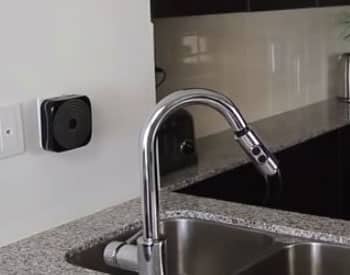
Ubi
Description:
Ubi is an Android-based “ubiquitous computer” that, the designers claim, will eventually be able to do just about anything that involves the Internet. Ubi includes a number of environmental sensors and integrates with other smart home gadget ecosystems like Nest and SmartThings.
Price: $399
Connectivity: Wifi
Catchphrase: "Ok Ubi"
Additional: Postscapes Coverage

Echo
Description:
Echo may live in your home, but its brains are in the cloud with the power of Amazon Web Services. In addition to looking up information and controlling other smart home devices, Echo has instant access to streaming music and other content from Amazon’s own selections and third-party services like Pandora, iTunes and Spotify.
Price: $199 (Beta - invitation only)
Connectivity: Wifi / Bluetooth
Catchphrase: “Alexa” or “Amazon”
Additional: Postscapes Coverage
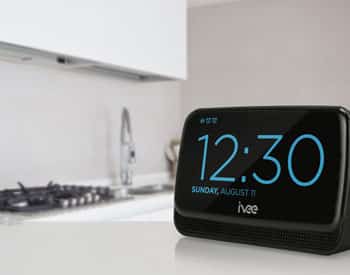
ivee Sleek
Description:
Ivee could easily be mistaken for a simple digital alarm clock—but there’s far more than mindless blaring coming out of this gadget. It can add voice control to countless other devices in your smart home, plus answer all kinds of useful questions by querying the Wolfram Alpha knowledge engine.
Price: $99
Connectivity: Wifi / Bluetooth
Catchphrase: “Hello ivee”
Additional: Postscapes Coverage
Cooking Devices
When it comes to actually cooking food, the IoT market is less robust than you might expect. We’re still waiting for the killer-app version of the notorious “smart toaster”, for instance. But there are a handful of devices that do put connectivity to use in the kitchen.

ChefSteps Joule Sous Vide
Description:
Wifi, Bluetooth and Alexa enabled this sous vide machines heats to a precision to 0.2°F / 0.1°C. Set it up and walk away, come back to a perfectly cooked meal.
Review: 4.4/5 (1,148 Reviews)
Price: $179.95
Connectivity: Wifi and Bluetooth

Range digital thermometer
Description:
Range is a precision food thermometer designed to play nice with today’s technology. It’s wired -- embedded electronics wouldn’t survive in the oven or on the grill -- and plugs into a phone or tablet to provide temperature graphs and instant readouts.
Price: $69.95
Connectivity: Bluetooth
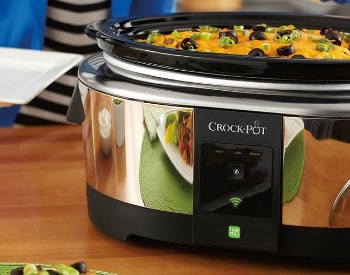
Crock-Pot Wemo Smart Wifi Slow Cooker
Description:
Even the original “dumb” version of the slow cooker managed to deliver on the Future Kitchen’s promise to free us from the demands of manual cooking: just toss the ingredients into the pot together, set the temperature, and walk away. The Smart Slow Cooker, to be released by Crock-Pot any day now, goes one step further by making all the controls accessible via users’ smartphones. It’s powered by Belkin’s free WeMo app, which lets users start or stop cooking, adjust temperatures and cook times, and set alerts and notifications.
Price: $85
Connectivity: WiFi

Evercook Automated Pressure Cooker
Description:
Finally, there’s Everycook, which is designed for those who don’t feel as comfortable in the kitchen. Actually, it’s as close to a chef-in-the-box as we’ve seen: part food processor, part pressure cooker, and part robot. First, select a recipe from an online database through the mobile app. Then feed the required ingredients through the slicer and into the cooking pot. A mechanical stirring paddle keeps things moving, and the heat settings and cooking time are handled automatically according to the recipe you chose. There’s even a scale so you don’t have to measure -- just add an ingredient until Everycook tells you to stop. It’s a neat idea, but Everycook has struggled with crowdfunding. Though the designer did not respond to Postscape’s request for a comment on the device’s future, work seems to be continuing.
Price: $Not yet available
Connectivity: WiFi

Mellow
Description:
Mellow is a remote cooking device designed specifically for sous-vide, in which food is placed in vacuum-sealed plastic bags and cooked slowly in steam or a water bath at low temperatures. It will hold food in its the tank at refrigerator temperature until it’s ready to cook, and you can use the mobile app to adjust settings and timers so your meal will be ready the moment you get home.
Price: $339
Connectivity: Wifi
Additional
- PanIntelligent
- Countertop
- Drop - Connected Scale
- Meld - "Meld upgrades your existing cookware and stove with automatic temperature control so every meal is perfect"
- Gina - Smart coffee maker
Faucets & Plumbing
We’ve already covered everything but the kitchen sink...might as well throw that in, too!

Hydropoint 360
Description:
Hydropoint’s 360 sensor installs on a homeowner’s cold water line, under the kitchen sink, and monitors vibrations that occur throughout the home’s plumbing system to determine exactly which fixture or appliance is being used—because a flushing toilet draws water differently from a dishwasher. This captured data can then be analyzed by machine learning algorithms to accurately calculate how much water each fixture is consuming, identify leaky pipes, alert a user to clogs or other upcoming issues, and recommend water saving options tailored to their specific usage patterns.
Price: $Unknown
Connectivity: Unknown
Additional: Postscapes Coverage

Ecomo Fount
Description:
Water quality has been in the news recently, with troubling revelations that what comes out of the tap in some communities isn’t safe to drink. While no home filtration system can protect against a truly broken municipal water supply, the Ecomo smart filter offers a little peace of mind to those who want to be sure of what’s in their local water.
Like many in-home filters, Ecomo attaches to the kitchen faucet. As water flows through, sensors in the device analyze it for heavy metals, bacteria, pH, harmful chemicals and other hazards. A color-coded LED ring gives instant feedback on water quality, and a mobile app offers detailed data and recommendations — including which of several included filters to use for optimal water.
Ecomo’s photovoltaic exterior provides solar power, while the interior hardware relies on microfluidics — technologies for precisely controlling the flow of tiny amounts of liquid — which CEO Eric (Zhiqiang) Liworked on at Carnegie Mellon.
Price: $Unknown
Connectivity: Unknown
Additional Resources:
- In The Smart Home, The 'Smart Kitchen' May Be Biggest Opportunity Of All - Michael Wolf - Forbes (2014)
Related: Connected Home Systems
Food Analysis
Looking to verify where you food has come from or if it is made up of what it claims to be?
Below are some technology devices targeting authenticity and origins in the food supply chain.


TellSpec
A handheld Bluetooth device that promises to tell users what’s in any food item at the press of a button, based on the spectrum of light that food reflects. Through a smartphone app, TellSpec will analyze ingredients, count calories, and warn about allergens or toxic chemicals like mercury.
Let’s get the inevitable comparison to Star Trek’s instantly-analyze-anything tricorder device out of the way. Yeah, it’s kind of like that, but just for food (so far, anyway). Point the sleek palm-sized device at your meal, hold down the single button, and wait for a beep: in seconds, the chemical composition of the food pops up on your phone, cross-referenced with information about each ingredient.
TellSpec uses an infrared laser to perform a chemical analysis technique called Ramen spectroscopy. When hit with infrared light, any atom or molecule will bounce back light of a distinctive and slightly different set of wavelengths. TellSpec collects the mish-mash of reflected light and sends that data to a cloud-based server, where an algorithm teases apart the light signatures of this or that compound and reports back to you with the results.
Knowing exactly what’s in your food is an empowering tool, especially for people with sensitivities or allergies to ingredients like gluten or lactose. Not only would it give consumers greater control over what they put in their bodies; it would also let shoppers and diners hold food producers and restaurants to account for misleading or neglectful food labelling. The company claims TellSpec works even through clear plastic and glass, so it’s useful everywhere from the home to the grocery store to restaurants.
The big question is how reliable and accurate TellSpec’s analysis truly is. The company claims better than 97% accuracy in its own tests, and is working with university researchers to do more tests and document the results in academic publications. The analysis engine is built on a learning algorithm, so the more people use TellSpec, the better the results should become.
The TellSpec device is available now for enterprise customers starting at $1900 for the hardware device.
Check out the video for more details on how TellSpec works.
Growing Plants
Wouldn't it be nice to grow your own herbs straight from your kitchen? These smart devices allow you to simply monitor and control a small device to do just that. Driven by low energy and high powered LEDs, aquaponic pods.
AeroGarden Farm
Highlights
- Grow up to 24 plants at once
- Receive reminders to add water and nutrients
- Includes soil free seed pods
AeroGarden Harvest Elite WiFi
Highlights
- Grow up to 6 plants in soil less pods
- Most plants germinate within 7-14 days, are ready for harvesting in 4-6 weeks
- Non-GMO Seeds
Click & Grow Smart Garden 3
Highlights
- Gorw 3 plants at a time (Use $9.99 Plant Pods for easy growing)
- Only consumes 8W of power.
Smart Indoor Gardens
See a complete list of aquaponic smart gardens for your kitchen
Ideas / Closed Companies
With every new successful technology there are usually a few dozen of failed ideas that came before it.
We highlight some smart kitchen devices that either the market didn't support or never reached consumers.

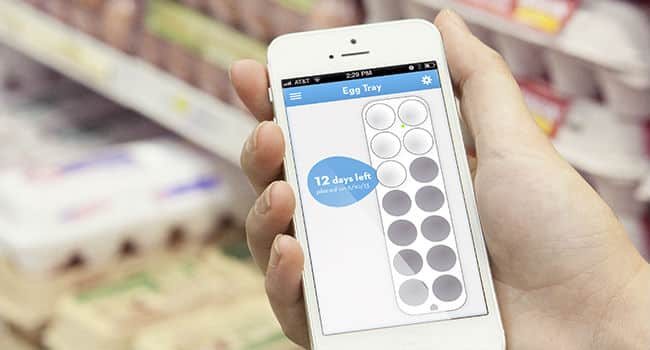
Smart Egg Tray: Eggminder
The Eggminder was the first connected device coming out of the gates for the GE and Quirky “Wink:Instantly Connected” collaborative product line.
The smart egg tray lets you know how many eggs you have left in the fridge while you are out at the grocery store via its built-in WiFi connectivity (Driven by the Electric Imp card) and the Wink smartphone app.
The tray features a sensor installed in each egg slot that can help you keep track of recommended expiration dates based on when they were first placed in the carton and a built-in LED to alert you to the freshest eggs remaining in the last batch.
The product idea was originally submitted to the crowd developed product site by Rafael Hwang and has had over 1,266 Community influencers shape the final product during its creation. It did end up going on sale for a brief time but Quirky itself ended up shutting down and the continued development of the egg tray product line with it.


HAPIfork: Smart Utensil
Created by Hong Kong-based HAPILabs and designed by French engineer Jacques Lepine the HAPIfork (pronounced happy fork) wants to help users lose weight and decrease digestive problems by reminding them to eat a little bit slower. Using a capacitive sensor and a built-in vibration motor the fork will send out gentle physical notifications or small indicator light flashes when it measures that you are eating at a difficult to digest pace.
All of your eating data is transmitted via Bluetooth to your smartphone and an online tracking dashboard where over time you can monitor when you started and finished your meals, the amount of “fork servings” taken per minute and per meal, and the specific duration of each “fork serving” interval.
The product launched but with poor reviews did not continue into further development.
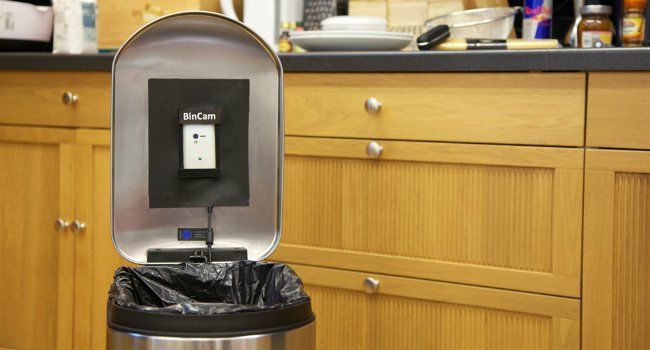
BinCam: Trash Can Recycling Monitor
BinCam, a research project from Newcastle University, gives a new meaning to the term “e-waste.” Instead of electronics ending up in the trash, this receptacle uses electronics and a bit of social pressure to make owners more aware of their waste — and hopefully divert more of it into recycling and composting instead of the landfill.
It’s pretty simple. A smartphone under the lid snaps a photo every time someone drops in a “waste” item. The photo is automatically uploaded to Facebook, where the user’s friends and family can shame them for tossing a perfectly recyclable bottle, or for failing to compost their table scraps. At the same time, the BinCam Facebook app sends the picture out to Amazon’s Mechanical Turk service, where a real human being will score the photo based on whether each item is truly deserving of the lowly trash can. These scores also get pushed back to Facebook so users can compete to have the greenest household.
In essence, BinCam “gamifies” your trash — offering points and leaderboards in the hopes that it will be better motivation than a moralizing finger-wag about each person’s responsibility to care for the environment. Some commentators have argued that it’s a mediocre use of “smart” technology, which works best when it treats us as adults and presents the opportunity to make informed, ethically-motivated choices about our own behavior.
But the creators of BinCam say that the gaming tie-in to social media allows feedback from friends and family (both encouragement and peer pressure guilt-trips) to “normalize” proper waste disposal. And their published research on BinCam shows “an increase in both users’ awareness of, and reflection about, their waste management and their motivation to improve their waste-related skills.”
You could easily see the Mechanical Turk service being replaced in the future with smart packing technology or networked cameras that can identify the object and allow for identification and better sorting procedures.



